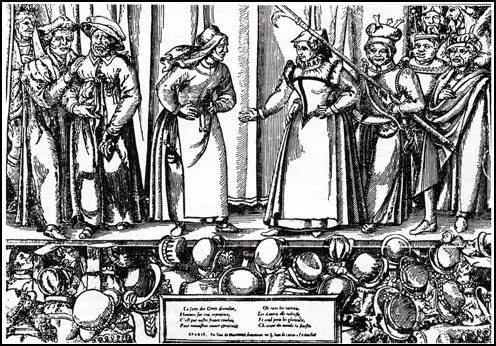Elizabethan Theatre
In Tudor England groups of strolling players toured the country performing plays. These plays were performed in barns and in the courtyards of inns. One of the most popular subjects of these plays was the story of Robin Hood.
The English government did not approve of strolling players as it was worried that plays on subjects such as Robin Hood would encourage the people to become rebellious. Another fear was that strolling players were responsible for spreading diseases such as the plague.
In 1572 a law was passed banning strolling players from touring the country. The only actors allowed were those employed by noblemen. During the next two years, Elizabeth gave permission for four noblemen to start their own theatre companies. However, actresses were not allowed to join. Women's parts had to be played by young boys.
At first these theatre groups performed in the courtyards of inns. These inns could only provide seats for small audiences. Therefore, in 1577 Robert Dudley, Earl of Leicester, built a permanent theatre in London for his group of actors. This venture was a great success and it was not long before there were several theatres in London. Prices were low so most people who lived in London could afford to go to the theatre. It cost only a penny to stand but it was extra if you wanted to sit down.

By 1595 over 15,000 people a week were attending plays being performed in London theatres. There was now a great need for new plays to be written. The most important playwright of the period was William Shakespeare . His first play, Henry VI, was performed in 1592. In the next eleven years twenty-three of Shakespeare's plays were performed in London. These included Richard III, Hamlet, Romeo and Juliet, The Merchant of Venice, King Lear, Macbeth, and Julius Caesar.
Shakespeare also wrote several-plays about former kings of England. Plays that showed weak and corrupt Yorkist kings such as Richard III were very popular with the Tudors.
Elizabethan plays were often used as propaganda. For example, a play called A Larum for London, that showed Spanish soldiers killing innocent civilians in Antwerp, was performed many times during Elizabeth's conflict with Philip II in the 1580s.
| Spartacus E-Books (Price £0.99 / $1.50) | ||||||
|---|---|---|---|---|---|---|
Primary Sources
(1) Stephen Gossen, The School of Abuse (1579)
In the playhouses at London it is the fashion of youths to go first into the yard, and to carry their eye through every gallery, then they go and sit as near to the fairest as they can.
(2) Bishop Hugh Latimer, preaching a sermon in 1549.
I came to a place on my way to London... I thought I should have found company in the church... but the church door was locked.... one of the parish comes to me and says: "Sir this is a busy day with us, we cannot hear you, it is Robin Hood's day."... Robin Hood, a traitor and a thief... it is a weeping matter... when people prefer Robin Hood to God's word.
(3) John Stockwood, preaching a sermon at St Pauls Cross in 1578.
The blast of a trumpet will call a thousand people to see a filthy play... an hour's tolling of a bell would only bring a hundred people to a sermon.
(4) Richard Morrison, The Laws of England (1535)
Robin Hood plays should be forbidden and others devised that show the wickedness of the bishop of Rome, monks, nuns and such like... Things sooner enter by the eyes, than by the ears: remembering more when they see rather than when they hear.
Student Activities
Henry VIII (Answer Commentary)
Henry VII: A Wise or Wicked Ruler? (Answer Commentary)
Henry VIII: Catherine of Aragon or Anne Boleyn?
Was Henry VIII's son, Henry FitzRoy, murdered?
Hans Holbein and Henry VIII (Answer Commentary)
The Marriage of Prince Arthur and Catherine of Aragon (Answer Commentary)
Henry VIII and Anne of Cleves (Answer Commentary)
Was Queen Catherine Howard guilty of treason? (Answer Commentary)
Anne Boleyn - Religious Reformer (Answer Commentary)
Did Anne Boleyn have six fingers on her right hand? A Study in Catholic Propaganda (Answer Commentary)
Why were women hostile to Henry VIII's marriage to Anne Boleyn? (Answer Commentary)
Catherine Parr and Women's Rights (Answer Commentary)
Women, Politics and Henry VIII (Answer Commentary)
Historians and Novelists on Thomas Cromwell (Answer Commentary)
Martin Luther and Thomas Müntzer (Answer Commentary)
Martin Luther and Hitler's Anti-Semitism (Answer Commentary)
Martin Luther and the Reformation (Answer Commentary)
Mary Tudor and Heretics (Answer Commentary)
Joan Bocher - Anabaptist (Answer Commentary)
Anne Askew – Burnt at the Stake (Answer Commentary)
Elizabeth Barton and Henry VIII (Answer Commentary)
Execution of Margaret Cheyney (Answer Commentary)
Robert Aske (Answer Commentary)
Dissolution of the Monasteries (Answer Commentary)
Pilgrimage of Grace (Answer Commentary)
Poverty in Tudor England (Answer Commentary)
Why did Queen Elizabeth not get married? (Answer Commentary)
Francis Walsingham - Codes & Codebreaking (Answer Commentary)
Sir Thomas More: Saint or Sinner? (Answer Commentary)
Hans Holbein's Art and Religious Propaganda (Answer Commentary)
1517 May Day Riots: How do historians know what happened? (Answer Commentary)




